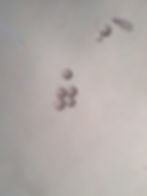
Moon Jellyfish
Aurelia sp.
Inarguably the most widely kept and cultivated species of jellyfish both in public and home aquariums. The combination of being relatively easy to keep and culture and the large number of offspring produced have earned them this title. Found all over the world, there are currently 28 recognized species of Aurelia. A bit of a taxonomic nightmare, Moon Jellyfish may have different physical traits depending on the conditions they were raised in. To make matters worse, some species have been introduced to new localities. Size varies greatly between species, but some may reach 15+" in the wild. Commonly found seasonally in large blooms.

In south Florida, Aurelia marginalis are often found in a beautiful pink shade. As seen below, this eventually fades in captivity and is related to diet.

Caring For Moon Jellies
Despite being the most widely kept species of jellyfish, I would not necessarily rank them as the easiest. Definitely within the range of a beginner species, but not the indestructible animals some may make them out to be. With such a widespread distribution, there is a species for every climate. Most of the species kept and bred now are temperate, thriving at common household temperatures.
Stocking density: Moon Jellies can be kept at a higher stocking density than most. Their combination of short tentacles and relaxed movement means they won't tangle like sea nettles might. Keeping too many together cant stunt growth or cause water quality issues, however. We recommend around 1 Moon jelly 1-2 gallons of tank space. So in a 5 gallon jellyfish tank you could comfortably house 3-5 Moon jellies.
Flow: Medium flow is best for Moons. They aren't super active and need a little help being pushed around the tank but don't like aggressively high flow.
Feeding: In terms of feeding capabilities, moon jellies are somewhere in the middle. They can eat medium particles of food. Baby brine shrimp, jellyfish pellets and finely chopped mysis shrimp are great options.
Compatibility with other species: Although their sting has a weak effect on humans, moon jellies don't play nice with other species. They will sting and sometimes even eat other species of jellyfish. It's a good idea to make sure you're keeping them with Moon jellies of the same species too. The safe bet is to not mix and match moon jellies from different suppliers.
Temperature Range: 65-75 F (this may vary depending on the species you are keeping!)
Salinity: 1.023 SG or 31 ppt
Life Stages (Click to scroll through)







Comparison of two species of Aurelia ephyra
